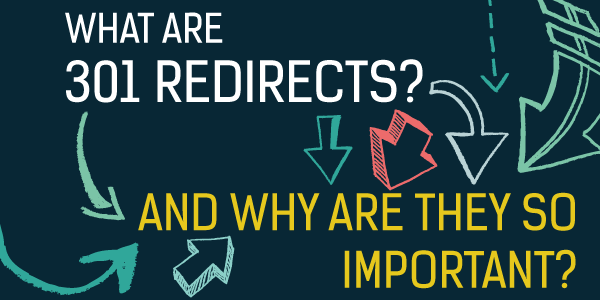What are 301 Redirects and Why Are They So Important?
Web Development

Without getting too technical, a 301 redirect is a permanent redirect from one URL to another and it’s the simplest, most efficient, and search engine friendly way to redirect any website. Just ask Google’s Matt Cutts, who actually recommends a 301 redirect over any other type of redirect. Much like a “change of address form” is necessary to let the post office know of your move and to forward any mail to a new address, 301 redirects let search engines know that your site has changed to a new location and to make sure to direct visitors to the new web address.
What Makes 301 Redirects So Great?
- 301 redirects usually passes 90-99% of SEO ranking power or link juice to the new page and is the best method for redirecting a website and keep your authority on the web. All social media campaigns, link building, Facebook likes will still be kept and pointed to the new site.
- It provides better user experience for visitors. They’ll automatically be redirected to the new website without having to click through or pass through any additional pages or links to get to it.
- Search engine bots that are crawling on websites for content will be informed that the pages have been moved to another location, creating less confusion and requiring them to crawl less pages in search of content.
What Can 301 Redirects Be Used For?
It’s good to note that 301 redirects are permanent redirects to a new URL so they’re best to use when:
- A company decides to rebrand and launch a new website to replace an older website.
- A new URL has been created to include important key words and phrases.
- Web pages that are ranked, but will be deleted from the website.
- A consolidation of multiple sites will be replaced with one, single, main website.
- Temporary campaign websites that will inevitably go off-line in a number of weeks or months.
To conserve the most ranking power, we came up with a few tips when setting up a 301 redirect.
Don’t Move Without Setting Up First
We can’t stress enough that 301 redirects are permanent changes. So if you’re thinking about a new website, a homepage face lift, or a better URL, make sure you set up the redirect before you go through with the changes, don’t start a new domain from scratch. This will prevent you from losing all your SEO recognitions and rankings, which can be a huge bummer.Toys-R-Us made this mistake back in 2009 when they bought the domain Toys.com.
Pay Attention to Multiple Domains
Make sure redirects are setup between your different domains. Even Google reads https://www.smallscreenproducer.com and https://smallscreenproducer.com as two different websites. Be sure that Google is aware of all multiple domains and 301 redirects are set in place to be forwarded to your main website’s domain. This will let Google bots know that these multiple domains are yours and they won’t be off guard when the domains point to the main website.
Know About Other Redirect Options
Other things to note, be careful using other alternative redirects such as the temporary 302 and 307 redirects as these do not transfer any ranking power and shouldn’t be used. The only time a webmaster should use these substitutes is if he or she purposefully doesn’t want to pass any link juice to the new page or is letting search engines know that the change is for a limited time. Usually 302s are used when content is temporarily held on a certain page during web maintenance, for example.
Canonical tags are often used as 301 redirect alternatives and to benefit (some, not all) search engines. They’re often incorporated when you have the same content on multiple pages (with different URLs) and don’t want to be dinged for having duplicate content. Canonical tags let Google know that you are aware of your duplicate content and lets the search engine know which page you’d prefer to appear on search engine results pages. Although canonical tags pass the same amount of link juice and will be treated similarly by Google, we recommend using 301s because they’re preferred by Google and all other search engines, not just some.
Setting up website redirects can be a tricky and time-consuming process, so we recommend talking to your web master or web developer if you need help and to avoid losing any important SEO entities. Feel free to let us know if you have any questions or would like to learn more about our website design and development services.

